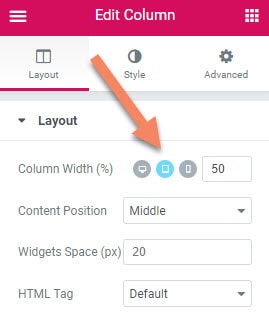

- #HTML TABLE RESPONSIVE COLUMNS HOW TO#
- #HTML TABLE RESPONSIVE COLUMNS GENERATOR#
- #HTML TABLE RESPONSIVE COLUMNS FREE#
You can try to convince editors to change markup directly – good luck! We would need to add additional class to tinyMCE editor in order to be able to mark table to act responsive on smaller screens just by adding special style for table using editor’s dropdown box. So you can see that table has only thead element without proper th elements. Markup structure for table is following: The following table shows the grid layout and column/row headers: Tip.
#HTML TABLE RESPONSIVE COLUMNS HOW TO#
This blog post is about how to adapt and automate a bit solution to fit for tables created by EPiServer tinyMCE editor.Įven if we specify that table has header and body: Items are laid out in rows, with the same data attributes in the same columns, with the rows often sorted with one or more sortable attributes. I found an interesting solution CSS Tricks for transforming tables from column-based into row-based on smaller devices. HTML Tables Starting with the basics, a table in HTML is a layout format for displaying collections of items through a matrix of rows and columns. We can simply add some utility classes to set the Flexbox grow rate for different columns.Whenever you need to represent data on the website in table format question about responsiveness and page look & feel on smaller devices arise. What happens if we have columns that contain data that we want to be wider or smaller in relation to the other columns? Luckily, Flexbox also makes this concern easy to implement. There are many types of tables on websites where content can vary as wildly as the approaches used to make them responsive. Responsive tables allow tables to be scrolled horizontally with ease. The problem with our table component is that every column is the same width. If not handled properly, columns can be cut off and thus unreadable. You can marge cell and add new rows, columns, cell.
#HTML TABLE RESPONSIVE COLUMNS GENERATOR#
In my snippet I set it to 600px And try to avoid inline styles. This HTML Responsive Table Generator helps you to generate desktop and mobile friendly HTML and CSS. That way you make them all regular block elements where the td s will flow below each other. However, this same benefit also has a shortcoming. You can use a media query in which you apply display: block width: 100 height: auto to table, tr and td. This gives us the flexibility to create tables with rows that have disparate numbers of columns. Each row simply splits the number of items into it, into equal columns. Given this implementation, we can easily create responsive tables. Given these criteria, we can write the HTML and Sass for our component as shown "breakpoint". Now all we need is a Table-header class that we can add to any row element to give it the styling of a header. Finally, we need the Table-row-item class, which is essentially a cell in the table component. Next we need a Table-row class, which will use Flexbox to make all its children (row items/ columns) flow by row without wrapping. First, we need the Table class, which will use Flexbox to make all its children (rows) flow by column.
#HTML TABLE RESPONSIVE COLUMNS FREE#
If you prefer to work in CSS, feel free to copy the generated CSS from the links to the Sassmeister examples.Īll we need is 3 basic classes to construct our Table component.

autoprefixer for help generating the necessary Flexbox CSS vendor prefixes, and Breakpoint to help with our media queries. We will use a few Sass libraries to aid us in our task.

This will give us the benefit of being able to create responsive tables that look great on all screen sizes.įirst off, the solution will be written with Sass in a modular fashion using SUIT CSS. Let's explore an alternative approach using divs and Flexbox. It also rocks a nifty hover effect that only spices things up for your convenience. They require a lot of boilerplate and nested HTML to solve such a simple problem. The table features a responsive layout that instantaneously adapts to smartphones, tablets and desktop computers.


 0 kommentar(er)
0 kommentar(er)
